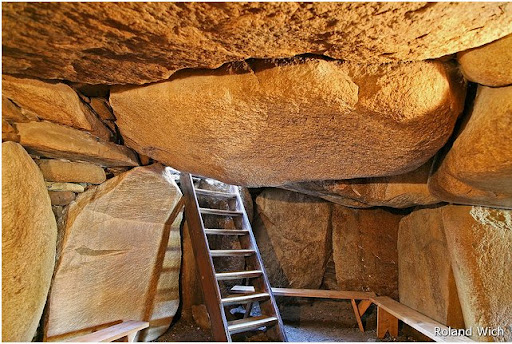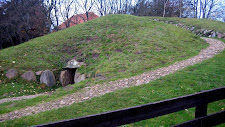Verirrte Steine
...oder "Papa?! Was ist eigentlich ein Hühnergrab..?"
par Planipedes
 Allemagne > Schleswig-Holstein > Nordfriesland
Allemagne > Schleswig-Holstein > Nordfriesland
|
|
||||
|
|||||
| Infrastructure |

|
| Préparation nécessaire |

|
![]() Description
Deutsch
· English
(Anglais)
Description
Deutsch
· English
(Anglais)
 On this place you can find more than a dozend megaliths and a big number of smaller foundlings. They were discovert more than 140 years ago, but there are a lot of questions left, nobody can give a sure answer until today. Megaliths (-> greek mega = big, lithos = stone) are named "erratic blocks" by geologists (-> lat. erratus = estray, thus "strayed stones" -> "verirrte Steine"), which lay around on the earths surface without correlation to the surrounding stone mass. They arise from regions, which are partially far away from their actual place. Geologists assume, that the blocks were detached from the high mountains and through huge forces taken from their original homeland. Which forces this might have been is in the most cases ambiguous.
On this place you can find more than a dozend megaliths and a big number of smaller foundlings. They were discovert more than 140 years ago, but there are a lot of questions left, nobody can give a sure answer until today. Megaliths (-> greek mega = big, lithos = stone) are named "erratic blocks" by geologists (-> lat. erratus = estray, thus "strayed stones" -> "verirrte Steine"), which lay around on the earths surface without correlation to the surrounding stone mass. They arise from regions, which are partially far away from their actual place. Geologists assume, that the blocks were detached from the high mountains and through huge forces taken from their original homeland. Which forces this might have been is in the most cases ambiguous.
 but
but  even more probable is the theory that the northern hemisphere of the earth was once covered with a bulky icecoat. Later the icemasses melted and established glaciers which shrank over thousands of years, moving slowly over the lowlands. Those took the stoneblocks away, which were torn from the Alps maybe. The glaciers formed and ground the huge stones and left them somewhere behind.
even more probable is the theory that the northern hemisphere of the earth was once covered with a bulky icecoat. Later the icemasses melted and established glaciers which shrank over thousands of years, moving slowly over the lowlands. Those took the stoneblocks away, which were torn from the Alps maybe. The glaciers formed and ground the huge stones and left them somewhere behind. Even probable is another theory that the stones might have been moved by swimming ice masses, the megalithes could have been captured inside. The stones you can find here have a similar consistency like the stonemasses from the Jura mountains in Switzerland and you can find many of them at different places in Germany and other parts of Europe like Poland, Russia and the Scandinavian regions. On the other hand it is also possible that the stones were moved at the time of the expansion of the ice masses. This would mean, rather, the stones come from the Scandinavian site.
Even probable is another theory that the stones might have been moved by swimming ice masses, the megalithes could have been captured inside. The stones you can find here have a similar consistency like the stonemasses from the Jura mountains in Switzerland and you can find many of them at different places in Germany and other parts of Europe like Poland, Russia and the Scandinavian regions. On the other hand it is also possible that the stones were moved at the time of the expansion of the ice masses. This would mean, rather, the stones come from the Scandinavian site.
 The wheel had not been devised yet and there had not been any metal to build stable tools to accomplish those difficult missions. All they had were stones, wood and ropes made of plants. They used those materials to braid nettings, in a fashion, that many people could pull on. Via cranks and digging methods they had the ability to move the megalithes away from their founding spot. Instead of wheels they used bobbins made of tree trunks which were finished with hatchets and stone knifes. In that way they managed the transport of the heavy-weight stones over many miles. Every time a bobbin got free at the end of the pulled megalithe it was brough to the front to use it again. At the end, at the destination, for instance here in Wenningstedt, the Stone Age humans arranged seatings, the megalithes were set in and could be errected to have a kind of wall. When the walls were finished, the arrangement was filled up with soil and with even more effort the coverstones were fit. At last, after completition, they removed the soil from the cave.
The wheel had not been devised yet and there had not been any metal to build stable tools to accomplish those difficult missions. All they had were stones, wood and ropes made of plants. They used those materials to braid nettings, in a fashion, that many people could pull on. Via cranks and digging methods they had the ability to move the megalithes away from their founding spot. Instead of wheels they used bobbins made of tree trunks which were finished with hatchets and stone knifes. In that way they managed the transport of the heavy-weight stones over many miles. Every time a bobbin got free at the end of the pulled megalithe it was brough to the front to use it again. At the end, at the destination, for instance here in Wenningstedt, the Stone Age humans arranged seatings, the megalithes were set in and could be errected to have a kind of wall. When the walls were finished, the arrangement was filled up with soil and with even more effort the coverstones were fit. At last, after completition, they removed the soil from the cave.
 toures, and they take care to prevent it frombeeing vandalised a.s.o. Anyone who wants to learn more about megalithes and foundlings, the movement of the stones and the mystic world of stone age tribes, should come here during the opening hours (Monday to Saturday, from 10:00 a.m. to 5:00 p.m. - except in the winter, guided tours prior consultation). Contact is the domestic association Söl'ring Föriining.To get the log-approval you have to solve two questions: 1.) Which special attribute does the edgestone at the westside of the passage "show"? 2.) What is the disk club (Scheibenkeule) made of, which was found inside the tomb in 1868? Take a photograph of yourself and/or your team in front of, on top of or inside the hub and post it after appoval to your log. Please send your answers to the eMail-address "answer 1"."answer 2"@online.de (example: Abrasion.Marble@online.de) - in case the answers are correct, you will receive the logapproval immediately. Please write your nickname into the mail-heading, so i can relate it to your log. I'm sorry, but logs without logapproval are subject for deletion.
toures, and they take care to prevent it frombeeing vandalised a.s.o. Anyone who wants to learn more about megalithes and foundlings, the movement of the stones and the mystic world of stone age tribes, should come here during the opening hours (Monday to Saturday, from 10:00 a.m. to 5:00 p.m. - except in the winter, guided tours prior consultation). Contact is the domestic association Söl'ring Föriining.To get the log-approval you have to solve two questions: 1.) Which special attribute does the edgestone at the westside of the passage "show"? 2.) What is the disk club (Scheibenkeule) made of, which was found inside the tomb in 1868? Take a photograph of yourself and/or your team in front of, on top of or inside the hub and post it after appoval to your log. Please send your answers to the eMail-address "answer 1"."answer 2"@online.de (example: Abrasion.Marble@online.de) - in case the answers are correct, you will receive the logapproval immediately. Please write your nickname into the mail-heading, so i can relate it to your log. I'm sorry, but logs without logapproval are subject for deletion.Happy caching, Planipedes!
![]() Indice additionnels
Indice additionnels
![]() Déchiffrer
Déchiffrer
jnyyp uneg
A|B|C|D|E|F|G|H|I|J|K|L|M
N|O|P|Q|R|S|T|U|V|W|X|Y|Z
![]() Utilités
Utilités
Cette géocache est probablement placé dans les zones de protection suivantes (Info) : Vogelschutzgebiet Ramsar-Gebiet S-H Wattenmeer und angrenzende Küstengebiete (Infos)
 Montrer les recommandations de cache des utilisateurs qui ont recommandé ce géocache : tout
Montrer les recommandations de cache des utilisateurs qui ont recommandé ce géocache : tout
 Chercher des géocaches prés:
tous -
trouvable -
même type
Chercher des géocaches prés:
tous -
trouvable -
même type

 Télécharger en fichier :
GPX -
LOC -
KML -
OV2 -
OVL -
TXT -
QR-Code
Télécharger en fichier :
GPX -
LOC -
KML -
OV2 -
OVL -
TXT -
QR-Code
 Lors du téléchargement de ce fichier, vous acceptez nos conditions d'utilisation et la licence de données.
Lors du téléchargement de ce fichier, vous acceptez nos conditions d'utilisation et la licence de données.
![]() Logs pour Verirrte Steine
Logs pour Verirrte Steine
![]() 49x
49x
![]() 0x
0x
![]() 0x
0x
 22. novembre 2023, 12:25
MOT09
trouvé la géocache
22. novembre 2023, 12:25
MOT09
trouvé la géocache
Nachdem ich am 19.10.2011 - während eines Herbsturlaubs auf Sylt - "Verirrte Steine" auf GC.com geloggt habe, stand heute - wieder im Herbsturlaub auf der Insel - sein Pendant auf OC.de an.
Vielen Dank an Planipedes für 'Verirrte Steine' und dessen Pflege (auf beiden Plattformen). Es grüsst MOT09
Denhoog - Verirrte Steine

 29. juin 2023, 17:47
kfamsi
trouvé la géocache
29. juin 2023, 17:47
kfamsi
trouvé la géocache
Auf Wanderung von Westerland nach Wenningstedt haben wir auch dieses besondere Grabmahl besucht. 29. Juni 2023 17:47, #192
Danke fürs Erklären, kfamsi
kfamsi@OC114AF

 06. juin 2023, 16:00
MatthiasEBS
trouvé la géocache
06. juin 2023, 16:00
MatthiasEBS
trouvé la géocache
Auf dem Tagesausflug nach Sylt mit der ganzen Familie wurde noch der Denghoog, direkt neben der Kirche (bzw. "Friesenkapelle") in Wenningstedt, besucht. Allerdings haben wir den Grabhügel nur über den Zaun angeschaut.
Die Fragen konnten gut beantwortet werden.
Danke für den Earth-Cache.
Dies ist ein duales Log für einen dual gelisteten Cache.
MatthiasEBS @ Denghoog

 01. juin 2023, 19:59
ZatopekEmil
trouvé la géocache
01. juin 2023, 19:59
ZatopekEmil
trouvé la géocache
Vielen Dank fürs herlocken.
Schöne Grüße aus dem Sauerland
ZatopekEmil
Bild

















 Taille : aucune boîte
Taille : aucune boîte Statut : disponible
Statut : disponible
 Distance : 15 km
Distance : 15 km Caché en : 18. octobre 2010
Caché en : 18. octobre 2010 Inscription : https://opencaching.de/OC114AF
Inscription : https://opencaching.de/OC114AF Aussi listé au :
Aussi listé au :  49 trouvé
49 trouvé 0 pas trouvé
0 pas trouvé 0 Remarques
0 Remarques 2 Observateurs
2 Observateurs 0 Ignoré
0 Ignoré 385 Visites de la page
385 Visites de la page 19
19 

